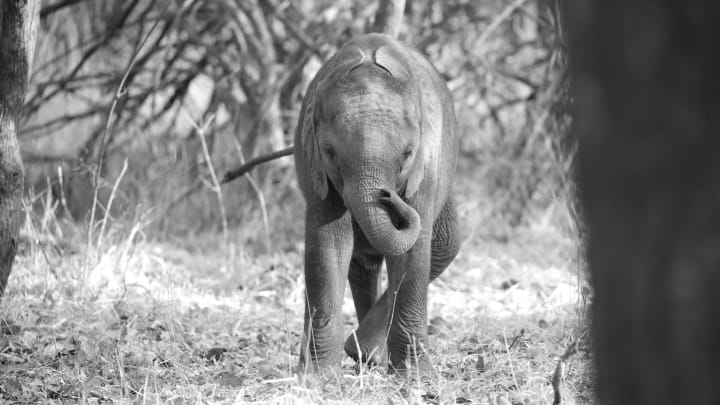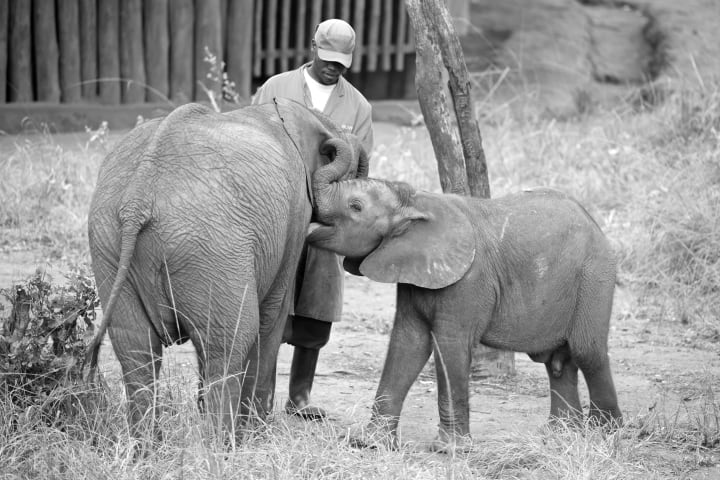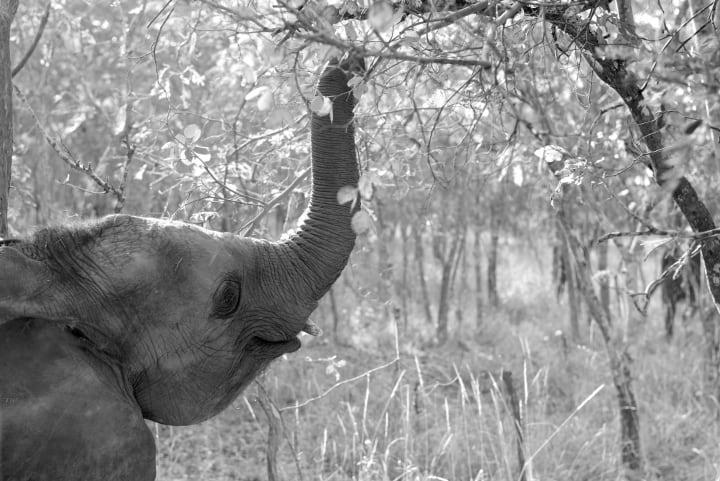From the Diary of a Conservationist—August 2015
An Elephant Called Zambezi

As the sun rises and the light starts to diffuse across the water of the Zambezi, an elephant drinks and a warm feeling enters your heart. Water rolls over the smoke that thunders, hippos huff and puff, and in the Luangwa valley, a lion's roar dances through the morning mist. A fish eagle looks patiently into the depths of the Kafue river and another day has begun in one of the most beautiful places on this delicate planet.
I am sitting in the Lilayi Game Reserve and can feel the warmth of the sun, breathing its energy into me, stronger and stronger with each passing minute as I watch a group of special little elephants walk off into the distance with two green-coated men. Amongst them is an elephant named Zambezi who I met for the first time in 2011. As he passes, he lifts his trunk, tastes the fresh morning air, and nods in approval. He seems happy with my presence. To me, Zambezi represents everything that is wonderful about Zambia and a conservation project that has formed its own special place in my heart. He is an elephant with charisma, happy, and full of the energy of life. He has faced hardships, yet he has never given up and now aged four is getting ready to make the next step towards a fully wild future.
Walking

On the road back to a wild life...
So who is Zambezi? With his ridiculous spiky hair and an endless obsession for climbing trees, “Bezi” is the little elephant who stole my heart.
I know that you should not have favorites, but I do and I am not ashamed to say that I do. I have spent time with many of the orphans, each with their own personality and story, but Bezi has a sparkle that has stolen my heart. As I sit with his keepers, Victor and Oscar, under tree, Bezi feeds on seeds pods with his fellow orphans Suni, Musolali, and Nkala. “Oh he is full of character that elephant,” says Victor, “not calm like Muso or naughty like Nkala and Suni.”
I met Bezi for the first time when he was just eighteen months old. As I walked with Rachel (Head of the Elephant Orphange Project) towards a crumbling, stable block, a tiny little elephant bumbled his way towards me. Trunk outstretched to greet Rachel, he nestled by her side and with a puff of warm air from his trunk and a low grumbling of affection, he left her to investigate me, a new friend who had arrived into his world.
On that day I walked and talked with Rachael, discussing the orphans and the issues elephants face. Never too far away was Bezi and his other tiny companions, eating and playing like all young elephants should. Rachel told me their stories and how these stables will soon be an elephant oasis, with a boma to keep them warm at night, a water hole for wallowing, a vet nearby, and a reserve where they can walk safely as they start their long journey back to the wild.
As for Bezi, his story had started six months earlier, recalled Rachael. “We had a call from Baines River Camp saying they had a tiny elephant that had fallen into their swimming pool.” Little Bezi, unable to use his trunk, had fallen in while trying to drink. Where his family was, no one was sure, but anthrax poisoning had occurred in the area the previous week. Alone and desperate for water, he had tried drink from the pool. Unable to use his trunk, he had fallen in and was now stuck.
An elephant's trunk is made up of hundreds of muscle and its dextrous nature is something that requires great skill if it is to be used effectively. As such, young elephants have to learn how to use and control it, of which is use for drinking is one such skill.
Luckily for him he had not ingested any anthrax and been poisoned. After his time in quarantine, he arrived a few weeks later at the Lilayi Nursery Facility to start a new life. A second chance amongst other young elephants who have had their lives transformed due to conflict opposed on them from human activity.
Now, four years on, he wanders through dappled sunlight of the Lialyi forest in front of me, enjoying the browse, occasionally stopping to raise a trunk of affection towards me and his extended family of keepers who have been acting as mother, older sister, and aunt, teaching him everything they can about being an elephant.
Such a happy soul, in six months he will embark on his next journey as he is translocated to the Kafue Release Facility, to meet some old friends and make new ones on his long walk back into the wild. Each elephant rescued will be released fully back into the wild and every effort made to remove the influence of their human upbringing.
Safety

In the forests of Lilayi...
As well as Bezi, the Elephant Orphanage Project (EOP) currently has thirteen other elephants in their care. Rachael heads up the team, supported by keepers and facility managers. Each with their own set of skills, from the intensive support and care shown at Lilayi, to the guidance given at Camp Phoenix, where the elephants make their final steps back towards a completely wild life in Kafue National Park.
It is no quick fix when it comes to looking after these elephants, most will undergo ten years of care and rehabilitation before being equipped with the skills and strength to survive in the wild.
If you had to use just one word to sum up the work of the team in Zambia, it would be dedication. Each elephant has its own set of needs, dependent on personality and the reasons that brought them to the project. Not all make it and I have witnessed and felt that emotion first hand with a little elephant called Ntuvia, who battled bravely for four weeks.
Then there was the amazing Suni, who was the bravest of all elephants. Suni sadly passed away after four years of fighting to recover from horrific axe wounds to her back. But I have also seen the highs with Mosi, when just forty-eight hours after rescue, went walking with his new family happily into the bush.
Suni

Keeping a watchful eye...
Like those people involved in the project, you also see in the elephants happiness, intrigue, concern, and sadness, as a mixture of emotions are blended together on a daily basis.
The rehabilitation process can be simplified into three stages;
The Rescue: A call comes in when an orphan has been located, with the team responding immediately, anywhere in Zambia. It is an organised operation, involving the support of the Department of National Parks and Wildife (DNPW) and a vet. The team is equipped to set up a temporary holding facility and provide any vital medical support to stabilise the young elephant, before transfer to the Lilayi nursery facility.
Arrival

A team effort...
The Rehabilitation: On arrival at Lilayi, a highly skilled team take over and start the hand rearing process, supported by any medical requirements—most often nutritional. The young calves are provided with milk formula, supplements, love and the necessary care to bring them back into a healthy physical condition, as well as to start to overcome the psychological trauma of losing their family. For success to be achieved, they need to be able to integrate and socialise with the other elephants, which plays a hugely important role in their emotional and social development. As young calves they are absorbed into the existing surrogate herd, the younger orphans learn new skills, gaining confidence under the guidance of the older elephants. Once weaned the young elephants move to the Kafue facility via a road translocation, to start the release part of the programme. As any mother knows its a full time job looking after a young baby, full of responsibility and sacrifice. A young elephant is no different, just a lot bigger, milk feeds are required every 2 to 3 hours, but 200ml becomes 2 litres, a few vegetables becomes 30kg of browse and the list goes on. Working in teams, the keepers at the elephant orphanage are a special group of people, who see these young orphans as if they were their own children. They work on a shift pattern, running through the day from 6am to 6pm. Then the night shift takes over, giving round the clock care to the orphans. Often traumatised at the beginning, the keepers gentle reassuring touch brings life and confidence back to these elephants. This intimate care leads to the development of special relationships based around trust. However no one elephant is dependent on one keeper, bonds are developed and each keeper speaks fondly of that one elephant whose story has touched their lives. “Chodoba and I will alway trust each other, I was there at his rescue and now wild it was so good to see him again the other day when he returned to say hello” Kelvin told me as we made our way to the viewing deck to discuss ways to teach and educate people about poaching and the threats facing elephants. Now working in the education programme, Kelvin was once head keeper and he was very proud to see young Chodoba gaining his independence. Unfortunately in 2016 Chodoba lost his life to a snake bite. Despite the sadness, comfort came from the death occurring back in the wild and part of the natural circle of life and not to the hands of human ignorance.
As you walk with the elephants and keepers in the bush, you gain a greater understanding of their role as surrogate mothers, as they teach the elephants understanding of their environment. What to investigate, what to stay away from, when to have fun, and when to behave! While this is going on, the rest of the shift team are preparing milk, cleaning the boma, and collecting browse for the night.
The orphans start walking early and by 7.30 AM they are deep in the bush searching, the only interruption being a milk feed for the younger elephants at 9 AM. They remain there until midday approaches, when they return to the boma for a lunchtime feed and health check. This lunch break allows the elephants time to play, and in the heat of the dry season enjoy a cooling bath while the keepers themselves can eat, knowing that their babies are safe from predators such as lions. By 2 PM they are back walking and learning about their environment and sustaining their huge appetites. Each day, an elephant will consume approximately ten percent of their body weight. As dusk approaches and the sun refracts on the dusty lands of the park, the elephants return and make their way to their “beds.” The younger elephants are stabled, while the older roam within the safety of the outer boma. Those like Suni, in the past, received their evening treatments of massage, aromatherapy, and acupuncture, while others just relax. For those still in need of milk, the feeds continue through the night, every two to three hours. Eventually the light of the stars is replaced by the morning rays of the sun and a new day of care begins.
Happiness

A new family...
The Release: As they grow and are no longer reliant on the keepers for milk, they are encouraged to spend most of their time in the National Park feeding naturally to fulfill their nutritional requirements, although they are still provided with some supplementary feeds and support, if required. Just like at Lilayi, keepers are present on the walk, but the elephants are very much in charge now. The orphans, however, still return each night to the boma and the safety of the large enclosure. Medical support continues if required, as health checks are carried out weekly. Eventually when strong enough to protect themselves from predators such as lions, the option to stay out and wander comes into play.
Those who feel ready enjoy complete freedom to come and go as they please. Still monitored through tracking a distance, but a watchful eye is kept on them. We would not want them to face the same fate as their mothers!
Wild and Free

A new forest a new life...
Andrew White (@andrewsilentwildlife)






Comments
There are no comments for this story
Be the first to respond and start the conversation.